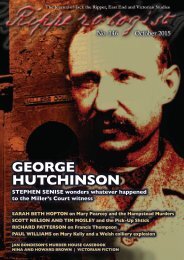Edmund Reid
nuhf574
nuhf574
You also want an ePaper? Increase the reach of your titles
YUMPU automatically turns print PDFs into web optimized ePapers that Google loves.
Overall, then, Hainsworth’s theory seems to me to stumble at the very first hurdle. In the first place, Macnaghten<br />
could have stated that the identity of the murderer was known and that he committed suicide without giving the<br />
potentially identifying details about when and how he died.<br />
Setting aside Hainsworth’s theory, off the top of my head the last book about Druitt was D J Leighton’s Ripper Suspect<br />
in 2006, and so much interesting information has come to light since then that a book bringing it together between two<br />
covers has been long overdue. I’ve already mentioned some of this information, namely Farquharson and Richardson. In<br />
1892 an East End Catholic priest allegedly left a sealed packet addressed to Sir Edward Bradford in which was revealed<br />
the identity of Jack the Ripper, information apparently received under seal of the confessional.<br />
Hainsworth also examines the “North-country Vicar” story; a north-country vicar claimed that a fellow clergyman<br />
had received under seal of the confessional an admission to having committed the Jack the Ripper murders. The vicar<br />
had agreed to make the admission public, but in a form so heavily fictionalised that the murderer’s identity could never<br />
be learned. The vicar himself apparently bore a name which would help identify the killer and he asked the newspaper<br />
not to publish it, a request to which the newspaper remarkably agreed and did nothing further to pursue the story.<br />
Hainsworth suggests the identity of the vicar.<br />
Jonathan’s discovery of the family connection between Montague John Druitt<br />
and Col. Vivian Dering Majendie (1836-1850), the Home Office’s first and muchrespected<br />
explosives expert, is new and interesting and evidently something to<br />
which he attaches great importance, believing him to be the conduit between<br />
Druitt’s immediate family and Macnaghten and Sims. This is a possibility: knowing<br />
the importance of the case and the way in which the failure of the police to catch<br />
the Ripper had badly tarnished the reputation of Scotland Yard worldwide, we<br />
may assume that Majendie, himself a Scotland Yard man and a friend of senior<br />
policemen, may have put the good name of the Metropolitan Police above his<br />
family name and conveyed family suspicions about Montague to Macnaghten. But<br />
what would he have expected Macnaghten to do - keep the information quiet<br />
and do nothing? Investigate the suspicions as would have been his duty, thereby<br />
bringing other people of different ranks in on the “secret”?<br />
Undertake no investigations, but leak the story to the press via journalist and<br />
writer friends like Griffiths and Sims, providing just enough information to set<br />
any self-respecting investigative journalist on the trail of the suspect’s identity?<br />
There’s not enough information to allow comfortable theorising, but the fact<br />
is that Macnaghten gave away sufficient information for Druitt to be identified,<br />
and if journalists had been more aggressive newshounds than they appear to have<br />
been, his identity would surely have been known. It is difficult to believe that he<br />
was really trying to protect anyone. Indeed, it is entirely possible that Druitt’s<br />
name was already in or making its way into the public domain, albeit not in print.<br />
Finally, Hainsworth has uncovered assorted stories which he believes to be<br />
based on the Thames drownee. Marie Belloc Lowndes classic The Lodger comes<br />
under scrutiny, as does a tale by Guy Logan.<br />
Also, three short stories by G R Sims. Like a lot of Hainsworth’s material, much of this material has been discussed<br />
on the forums, but this is the first time it has appeared in a book. It deserves close analysis. In fact, it’s a pity that<br />
Hainsworth has discussed his theory so extensively on the forums, where it must be said that his theorising has generally<br />
been greeted with disagreement and, it is sad to say, occasional vile comments.<br />
Jonathan Hainsworth comes close to writing a biography of the Eton-obsessed Macnaghten, a grown man embracing a<br />
little boy’s love of manly sports like cricket and a sense of adventure. He doesn’t achieve it - and a biography was never<br />
his intention - but his efforts to delve into the mind of the man to explain his view of the world and why he wrote what<br />
he did are well worth reading.<br />
Finally, there are some great new photographs in this book too.<br />
Overall, Jonathan’s book is a conspiracy theory and one that probably goes way over the top, Macnaghten being<br />
Ripperologist 147 December 2015 58




